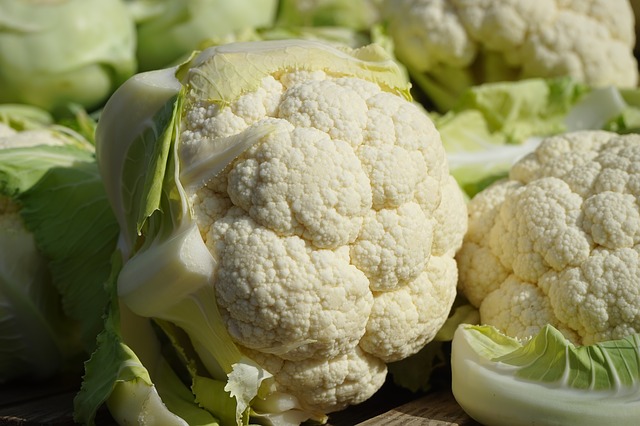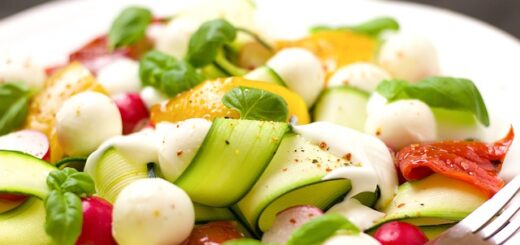Cruciferous Vegetables – 18 Pieces!

Cruciferous vegetables are vegetables that come from the cruciferous family. Cruciferae says something about the flower shape of the plants. This family includes 349 genera. So a big family. You can eat all members of this family, but not all are equally tasty. Some members have seeds that you cannot eat in large quantities, that would not be safe. Some are used for oil (rapeseed) others for fuel and consumption such as rapeseed. The reason why cruciferous vegetables are named separately is because these vegetables contain extra vitamins, minerals and fiber.
You can buy the cruciferous vegetables below in the Netherlands. You can find recipes everywhere in which these types of cabbage and their relatives are prepared. I would say: eat them plenty! They are bears healthy and also taste delicious.
Which vegetables are from the finial family:
1. Cauliflower
Our well-known cauliflower is a type of cabbage that is grown in different colors (orange, purple, yellow or green). In general, the white cauliflower is in the supermarket. You can eat cauliflower raw but you can also cook and steam it.
2. Green cauliflower turrets
This cauliflower, from the cruciferous vegetables, also has a greenish color and is smaller than the white cauliflower in general. It must be said that this Romanesco, as it is also called, is not in the shops in large numbers. After cooking, the color remains fairly the same.
3. Kohlrabi
Kohlrabi is a real winter vegetable. It is a root of the kohlrabi plant. Kohlrabi is almost no longer eaten in the Netherlands. It is a so-called ‘forgotten vegetable’. For several forgotten vegetables, see our blog about forgotten vegetables
4. Broccoli
Broccoli, a green cabbage, is also a cruciferous vegetable. It is often on the shelves with or next to the cauliflower. They are also related to each other. The closed flower buds of Broccoli are eaten. You can cook and steam it and eat it raw through a salad, for example, is also an option.
5. Red cabbage
Red cabbage is one of the oldest types of cabbage. It is a head cabbage crop. Red cabbage is often eaten with apples. You can also eat the red cabbage raw, cut into thin strips. Delicious at a vegetarian hair salon…
6. Cress
Garden cress or star cherry as it is also called in the Netherlands is a sprouting vegetable. They are easy to grow at home in a container. They are often grown at school or in school gardens. Cress is a present on a biscuit with sugar, for example…
7. Arugula
Arugula is an annual lettuce variety that has a distinct taste. A bit spicy and nutty. You can combine this arugula well with other raw vegetables and dressings. It is also delicious raw on the pizza after baking!
8. Turnip
The turnip or stubble has many names. In the Netherlands it is also a forgotten vegetable, which is a shame because you can prepare it in different ways. The turnip can also be eaten raw. The young leaves of the turnip are called turnip greens, which you can also eat.
9. Radish
The well-known red and spicy radishes can be sliced on the sandwich or in the salad. There is also a red and white variety of the radish. This one is slightly longer.
10. Chinese cabbage
The Chinese cabbage is an elongated cabbage that lacks the real cabbage flavor. It has a mild sweet taste and you can stir-fry, cook, stew and steam the Chinese cabbage.
11. Kohlrabi
Kohlrabi is a thickened stem of a cabbage plant. There are 2 colors of kohlrabi, white/greenish and purple. It’s not really a well-known vegetable but you can eat it raw, stir-fry and even use it in casseroles. The taste is a bit cauliflower or celery-like. Just try!
12. Horseradish
Horseradish is the root of the horseradish plant. The taste is sometimes compared to mustard or radish. So tasty. This root is available in powder form, fresh or in a jar. Delicious with sauces and dressings. Also delicious to use through dishes, but it can quickly dominate so use little by little.
13. Savoy cabbage
You can stir-fry, stew or boil savoy cabbage or green cabbage. Delicious in a stew or in an oven dish. The cabbage shrinks when it is heated.
14. Brussels sprouts or Brussels sprouts
Brussels sprouts are small cabbages that grow under each other on a stem that grows straight out of the ground. It is a real winter vegetable. When there has been frost, the Brussels sprouts are very tasty after harvest. The Brussels sprouts taste a bit bitter when you cook them for a long time, so cook them al dente. You can also steam or stew Brussels sprouts.
15. Wasabi
Next in the list of Cruciferous Vegetables is the wasabi. Wasabi is made from the root stem of the wasabi plant. Growing the right rhizome takes 1.5 years. The wasabi is often imitated from horseradish, mustard and radish, among other things. Wasabi has a really sharp taste.
16. Watercress
The watercress taste a bit peppery. They are small seedlings, just like the cress. Each ‘cherry’ variety tastes slightly different.
17. Kale
This typical winter vegetable is a leafy vegetable. The leaves are a bit hard but after cooking (cut) they are wonderfully soft. This vegetable is perfect for a stew, but certainly also for other dishes. If you keep it in the freezer, the kale will taste slightly sweeter than it has been frozen over.
18. White cabbage
Sauerkraut is made from white cabbage. It is an inexpensive cabbage that you can also process yourself in all kinds of dishes. You can boil it, stew it and eat it raw in a salad.
This is the list of Cruciferous vegetables that are readily available in the Netherlands.











